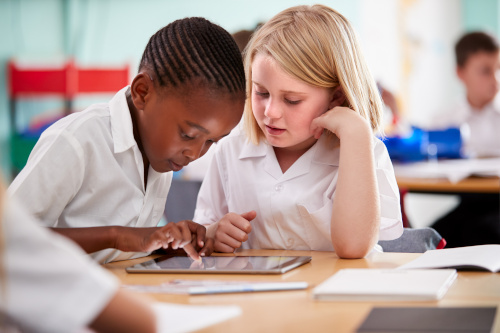Consider this: 95 percent of students have the capacity to learn to read, according to the National Institutes of Health, yet only about 34 percent of fourth and eighth grade students read proficiently, according to the National Assessment of Educational Progress. Is this disparity an achievement gap or an opportunity gap?
How we answer this question frames our thinking about solutions. If we look at the disparity as an opportunity gap, we are saying that all students have the same ability to achieve, but not all students have had the same opportunity to achieve.
Myriad opportunity gaps exist in the modern educational system—along with a pandemic that’s only widened these gaps—and are particularly prevalent among students of different races, ethnicities, and socioeconomic classes.
“The pandemic has stolen time from our children who have lost something sacred and irreplaceable this year. We will carry its impact for years to come,” U.S. Secretary of Education, Dr. Miguel Cardona stated at a recent press conference. “For too many students, your zip code and your skin color remain the best predictor of the opportunities you’ll have in your lifetime.”
The four pillars
Equity is a process. It’s not about checking off a box and crossing that task off your to-do list. Equity provides every student access to education focused on meaningful learning–one that teaches the deeper learning skills and empowers students to learn independently throughout their lives.
Equity can be downright daunting, and particularly when it comes to literacy education. The good news is that equity can be achieved through a series of identifiable, deliberate steps.
Here’s a framework that all schools can start using to ensure high levels of equity both for in-classroom and remote learning:
1. Quality curriculum. The first pillar of the Every Student Succeeds Act (ESSA) focuses on quality literacy curriculum and what that framework should look like. For example, is the curriculum informed by the science of reading (i.e., the evidence from vast and interdisciplinary research that has taken place over the past five decades)? Focused on reading acquisition and instruction, the research has helped inform ideas about proficient reading and how it develops. The curriculum must also be aligned to structured literacy, which helps us understand what to teach and how to teach it. Finally, what level of teacher knowledge is needed to deliver evidence-based instruction? With reading, the instruction must be explicit, with skills and concepts being taught in a direct systematic manner. All of these elements must be factored into a successful literacy curriculum.
2. High-quality assessments. Assessment is a powerful tool that helps teachers maximize impact, reduce redundancy, and allocate more time to instruction. By monitoring progress along the way, teachers can check in with students multiple times (not just once), identify areas of potential risk, and collect data that’s used to build profiles of strengths and weaknesses. Equipped with these and other measures, teachers can personalize and improve learning in a way that supports equity in literacy instruction. In addition to traditional assessments, ESSA also recommends performance-based assessments that measure things standardized, multiple-choice tests miss. High-quality, performance-based type assessments also provide a more equitable and fair testing environment that reaches a larger, more diverse student body.
3. High-quality instruction. Effective core reading instruction presents grade-level content. Concepts and skills are explicitly taught with clear goals and objectives and consistent routines that focus students’ cognitive resources on learning. The pacing of lessons keeps students actively engaged, and ongoing practice supports mastery of new learning. We want to make instruction as powerful as possible. That means thinking about resources, more instructional times, and smaller instructional groups. We also want to create targeted instruction that’s clear, systematic, and that includes opportunities for guided practices (e.g., practicing reading words and sentences and text and spelling words) and for error correction and feedback. These are all important factors for any student who is struggling with reading, and it helps educators figure out why he or she is struggling and then come with a plan of action.
4. High-quality intervention. Effective intervention, on the other hand, accelerates learning by intensifying the instruction and providing more than one year of growth for every year of instruction. This closes the gaps because the student who is receiving instruction is getting one year of growth, but the one who is getting instruction and intervention will typically come away with more than one year of growth. So, rather than asking the questions, “what tier does this student belong in?” we want to ask, “what level of intensity does this student need to respond to instruction?”
Don’t wait for failure to happen
We don’t want to wait for students to fail. We want to get these four pillars of success in place and add value before a student begins to encounter serious reading struggles. Using the proactive approach outlined above, schools will have the specific resources they need to give everyone the same opportunity to succeed. Remember, equity and improvement are both processes; they’re not events.
- 3 ways to avoid summer learning loss - April 19, 2024
- High school students say AI will change the workforce - April 18, 2024
- Motivating students using the Self-Determination Theory - April 17, 2024


